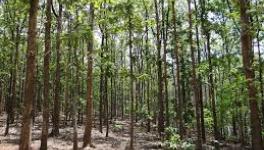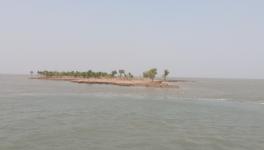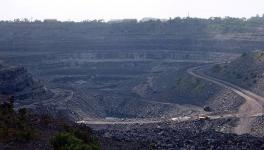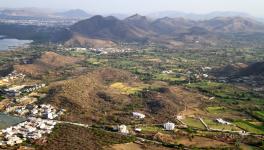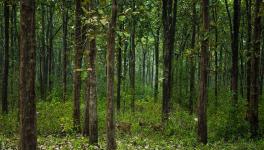Coal Mining Casts Shadow Over Assam’s Rich Biodiversity
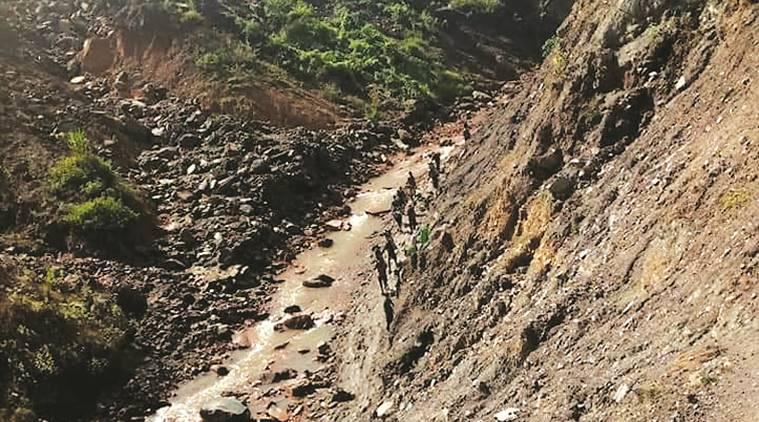
Representational image. | Image Courtesy: Indian Express
New Delhi: The chorus for banning all mining activities within the rainforests of Assam has been rising after the National Board of Wild Life (NBWL) recently granted clearance to coal mining in the region, allegedly overlooking ecological concerns.
Several civil society members and non-governmental organisation (NGOs) have demanded a total ban to any form of coal mining in the region, as they apprehend large-scale adverse impacts to environment and wildlife.
In April, NBWL gave clearance to North Eastern Coalfields (NEC), a subsidiary of Coal India Limited, for open cast mining over a lease area of 98.59 hectares in the Saleki area of the rainforests. The clearance was granted despite allegations that NEC had continued with illegal mining in the area even after the expiry of its 30-year lease period in 2003, without obtaining mandatory forest clearances from the government.
The massive rainforests of Assam are known to contain a very rich biodiversity of mammals, birds, amphibians, reptiles, butterflies, fish and orchids, as per several studies. Saleki, a ‘proposed reserved forest’, falls within that particular area of these rainforests which had been notified by the Central government in April 2003 as the Dehing Patkai Elephant Reserve.
“Rampant deforestation has been undertaken to carry out open cast mining in the elephant reserve. It has led to loss of wildlife as well as to several species of flora and fauna. The coal mined in this area is rich in sulphur and its extraction has polluted water bodies, too, thereby affecting aquatic life. There are a number of elephant corridors within the reserve. Mining activities have disturbed the movement of elephants in these corridors,” said Trinayan Gogoi of a Digboi-based NGO, Green Bud Society.
The townships adjoining the elephant reserve have in the past regularly reported intrusion by elephants into human habitations. Such intrusions are attributed by wildlife experts to depletion in the centuries-old natural elephant habitats.
The NGO has begun a campaign “I am Dehing Patkai”, which aims to conserve the ecology of the rainforests by stopping all forms of coal mining.
Saleki had been notified as a proposed reserved forest in June 1976 under Section 3 of the Assam Forest Regulation Act, 1891. However, its change of status to a full-fledged reserve forest is still awaited after more than four decades. Saleki also falls within the 10-km radius eco-sensitive zone of the Dehing Patkai Wildlife Sanctuary which is located within the elephant reserve. The NBWL clearance has been granted despite these facts.
“The NBWL clearance violates the concept of eco-sensitive zone as contained in the Environment Protection Act, 1986. The fact that Saleki remains a Proposed Reserved Forest even after four decades, is symptomatic of a larger malaise in the country. Its consequence is that such forests cannot come under scientific management. This makes the forests totally susceptible to misuse, which is evident in this case,” said environment lawyer Sanjay Upadhyay.
At the time Dehing Patkai was notified as an elephant reserve, the population of pachyderms in the area was 295. No legal mechanism exists in the country, however, for the protection of elephant reserves and corridors despite the fact that these are crucial ecological zones.
Kashmira Kakati, a wildlife biologist working in the North Eastern region of the country, has documented various rare and endangered species of birds and animals during her studies over the entire landscape of Dehing Patkai.
In her studies, Kakati has claimed the existence of mammals (49), birds (283), orchids (107), amphibians and reptiles (71), butterflies (306), fish (71) and odonates (40) over the landscape. These numbers include two critically endangered species, 13 endangered species and several species listed in Schedule 1 of the Wildlife Protection Act, 1972.
Based on a petition filed by Kakati, demanding a mechanism for preserving the fragile ecology of the elephant reserve and adjoining areas, the National Green Tribunal (NGT), in its judgement delivered in December 2017, had laid down a series of directions for the central government.
These directions included declaring the areas inhabited by elephants as conservation reserves by conducting surveys to ascertain the population of pachyderms in each state. The tribunal also directed the Central government to declare areas surrounding these conservation reserves as eco-sensitive zones.
The NGT had sought a report from the state and Central governments, in this matter, within one year. However, any action in this regard is yet to be taken as the Supreme Court has imposed a stay on this judgement.
The NBWL is chaired by the Union Minister of Environment, Forests & Climate Change (MoEF&CC) Prakash Javadekar. In October 2019, the North-Eastern regional office of MoEF&CC conducted a site inspection of NEC’s mining lease area in Saleki. Illegal mining was confirmed during the inspection though the team that undertook the survey did not report on the impact of mining activities on the local ecology.
Another team led by NBWL member Raman Sukumaran also conducted a site visit of the Saleki area in October 2019.
“The committee interacted with local villagers regarding the sighting of elephants in the corridors. They stated that there was occasional sighting of elephants in the area with greater frequency of movement during the paddy harvest seasons. A railway line passes through the Upper Dehing Reserve Forest West Block, where it was reported that in the past there have been casualties of the elephants,” the team stated in its report.
Again, though this team acknowledged reports about the rich biodiversity in the rainforest area, it did not take stock of the extent of damages suffered by wildlife on account of illegal mining activities.
A team of three senior officials of the Assam forest department had also conducted a field visit in July last year to areas of the rainforest that fall under the jurisdiction of the Digboi forest division. The Digboi forest division comprises the Saleki Proposed Reserved Forest, which is spread over 8,504 hectares, and a Reserved Forest area spread over 55,714.65 hectares. An area of 11,142 hectares within the Reserved Forest had been declared by the Central government as the Dehing Patkai Wildlife Sanctuary in June 2004.
This team, comprising Indian Forest Service (IFS) officials Anurag Singh, C Muthukumaravel and KSPV Pavan Kumar had, however, provided evidence of loss of forest areas due to rampant illegal coal mining in its report.
“A huge area of the RF [Reserved Forest] / PRF [Proposed Reserve Forest] has been lost due to illegal coal mining in Digboi division, the scale of which can be assessed by much detailed enquiry involving other departments,” the report stated.
The team found evidence of systematic open cast illegal mining, apart from rathole mining, inside the rainforests which had led to large-scale destruction of forest areas and the fragile terrain.
Illegal collection, stocking, loading and transportation of coal was also noticed, which affected the forests and wildlife. The team had also noted in its report that illegal mining of these dimensions possibly had the connivance of forest department officials and other agencies or departments.
“A forest cannot be seen as standing trees alone. It is a whole ecosystem. Any form of open cast mining automatically affects that ecosystem,” said Rajib Rudra Tariang, head of the zoology department of Digboi College.
When contacted by NewsClick, the Divisional Forest Officer (DFO) in-charge of Digboi, Atiqur Rehman, denied reports of illegal coal mining inside the reserved forest area. Rehman, however, admitted that the staff strength of Digboi division was too thin to keep a proper watch over the huge area under its jurisdiction.
“Out of the total sanctioned posts of 214, there are only 74 staff in the Digboi forest division at present. There are eight range offices in the division. But four of them are without rangers. So, each ranger has to deliver dual charges,” said Rehman.
Though Saleki has become a flashpoint ever since it was granted a wildlife clearance by the Central government despite being part of a proposed reserve forest, the NEC also has collieries in Tikak, Ledo, Tirap, Tipong and Baragolai in nearby areas.
Meanwhile, mining operations in Saleki, which is a part of NEC’s Tikak open cast mining project, were halted temporarily in the first week of June following protests over the clearance.
Other hazardous industrial activities, too, carried out within or in close proximity to the rainforests have been affecting the area’s ecology. In May, an oil well belonging to the public sector Oil India Limited in Baghjan in Assam caught fire that was raging as recently as last week. This area is in close proximity to the Maguri-Motapung wetland and is also near the Dibru-Saikhowa National Park. Environmental activists have reported ecological damages to the wetland resulting from the fire, as also large-scale displacement of people.
The writer is an independent journalist.
Get the latest reports & analysis with people's perspective on Protests, movements & deep analytical videos, discussions of the current affairs in your Telegram app. Subscribe to NewsClick's Telegram channel & get Real-Time updates on stories, as they get published on our website.









